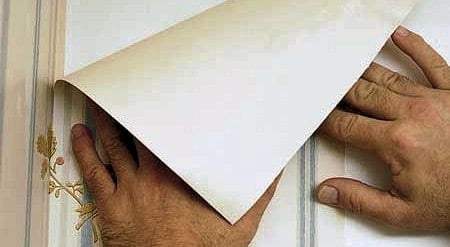For those of you who chose to wallpaper their rooms…
Continued from How to Successfully Paint a Room
With your walls all prepped, ceiling painted and all woodwork glossed…
You’re finally ready to add your wall paper.
But with wall paper, there are a few things to bear in mind.
Even before you choose the paper.
For instance, many patterned papers have a repeat in the pattern. These can range from between 6 inches (150mm) up to a huge 30 inches (750mm). Obviously the larger the repeat the fewer lengths (drops) of paper you will get out of a roll. A paper with a repeat of 18 inches (450mm), will generally give you 3 drops of paper (floor to ceiling) on an eight foot (2.4m) high wall. And as most wall papers come in a width of around 21 inches (500mm), we now have a means of estimating how many rolls of paper we would require to decorate a room.
Throughout the rest of this article, we will assume that you get 3 drops of wall paper, per roll.
So let’s do the maths…
Say for example that your room was 3 metres x 2.4 metres.
That would give us 2 walls at 3000 mm width, and 2 walls at 2400 mm. So 3000 + 3000 + 2400 + 2400 = 10,800 mm total width. Forget about any windows and doors for now.
Now divide that by the width of a roll (500 mm). 10,800 / 500 = 21.6 drops. Rounded up (to account for wastage) equals 22 drops (roll widths).
Then if we get 3 drops to a roll, we would need 8 rolls to cover our total wall area. 22 widths divided by 3 = 7.33 rolls required. Rounded up equals 8 rolls of wall paper.
Knowing what our wall paper requirements are now, it must be stressed that it is always best to get all the wall paper you need all in one go. And to be extra safe, maybe an extra roll too(just in case). It’s better bought in one go, because all wall papers are printed in batches. And sometimes colour differences can occur between different print runs (batches). For this reason, wall paper is packed with a batch number printed on the wrapper.
When buying your wall paper, it is imperative to ensure these batch numbers are all the same.
If not, at least purchase enough of a batch of wall paper to cover a whole wall. This way will ensure that any subtle colour changes can be blamed on the differences in the lighting falling on different wall surfaces.
So anyway, now we have got our wall paper purchasing sorted, let’s think about getting it hung. And for that we’ll need some wall paper paste.
Although Solvite wall paper paste is the world’s leading brand and is considered the market leader, you might over time find that many decorators actually steer clear of it.
This is because despite of its superior adhesion qualities, while hanging the paper, any paste residues between adjacent drops tend to leave behind a shiny finish on the paper (flashing). Even after being wiped away. And for that reason alone I would recommend a more traditional flour based wall paper adhesive. These can be a little harder to find in today’s DIY sheds, but they are still readily available.
When papering, most people will cut a length, paste it and hang it immediately. And then go onto the next length.
A decorator does it somewhat differently though. Without the need for measures, he would take his first roll and roll it out down the wall giving himself probably 5 or 6 inches spare. He will cut this drop to length (plus the excess) and lay it flat on his paste table. Leaving a big fold in the middle so that both ends would remain fully supported by the table. Next he would roll out his next length adjacent to the first at the same time matching the pattern and by doing so he knows where to cut the paper with enough length to cover the wall with the pattern correctly joined.
And repeating the procedure through the whole of the remaining wall paper, he now has enough evenly cut lengths of paper to finish the job.
>>video to follow<<<
With all his wall paper cut into lengths, our decorator now lays all the paper, pattern side down on his paste bench.
And he proceeds to paste four or five sheets in one go. This gives the paste some time to soak into the paper which in turn makes the paper a little more workable. The decorator will also pay more attention to the wall paper’s edges while pasting. Because it is generally the edges of a paper that can later lift along the seams between drops.
With five sheets of pasted wall paper at the ready our decorator will next paste the wall surface. He does this slightly wider than the roll’s width, where he wants to lay his first drop. He will then roughly lay the paper out onto the wall and check that it is running true with a plumb line running down the side of it.
If the paper isn’t plum (perfectly vertical), he will slide it around on the wall (another reason for pasting the wall), until it is perfect. When he will then proceed to properly hang the paper by brushing it all flat. And then it’s time for drop number two.
Now because the wall was pasted wider than the width of the first piece of paper there should be enough spare paste on the wall for our boy to be able to slide his next piece into position and when it’s there he fully flats it out. And he runs his paste brush up behind the edge where the next sheet will go and flats it all out again.
Can you see what he’s doing?
He is forever preparing the way forward for his next move. He’s doing this by pasting along the following edge. Whilst doing so, he’s lubricating the wall for the next drop ready to be slid into place.
This process is repeated for the full five drops that he had pre-pasted earlier. And when he has all five lengths hung, he then returns to the first length to trim the tops and bottoms of the wall paper. Giving it a proper fit between the pre-painted ceiling and skirtings (see How to Successfully Paint a Room).
After trimming all five lengths, our decorator is ready to go again with another five lengths.
And by doing it this way he has minimised the need to use ladders, brushes and scissors in a less stop, start, stop, start manner.
He has also effectively double pasted all his wall paper edges. Ensuring a better adhesion. And he’s not had to mark either the walls or the paper in order to hang it. Thus minimising any of those potential ‘black lines’ discussed in the previous post. But above all else, he has saved himself a shed load of time.
So that’s the way to professionally do it.
But there are a couple of other things worth noting before we begin which are:
- We first enter a room through the doorway. And that is generally how we view the room. From the doorway within.
- With this in mind, and the fact that our enemy broad daylight usually enters the room from the opposite direction, our decorator accounts for this by working in an order to counter any adverse effects this may cause.
- He will start at the window side of the room and paper back towards the doorway to help minimise any shadows caused by any overlapping in his wall papers.
- He will also work his way around a room so that any mismatch in the wall paper hanging will occur in the corner above the door. Where it is less likely to be noticed. Or in a corner of a bay window where he knows that some form of furniture will conceal it.
The professional decorator will always cut his wall paper into an internal corner too.
- And then use the off-cut to continue his perfectly matched paper around the corner.
- He does this because he knows that no walls on this planet are perfectly true.
- And to just spread his paper around a corner without cutting it, will almost always lead to the corner paper ‘blistering’ with the air that gets trapped behind it.
- Also the leading edge for the next drop would be banana shaped. As will the next, and the next, and the next. Each getting considerably worse as he goes.
- Likewise, an external corner can do the same. So when papering around a chimney breast say, our decorator will cover the front first and minimise his margins for error by making his adjustments on the chimney reveals. Where they are less noticeable and can be brought back inline before the next major drop.
When working with heavy duty wall papers…
It is always better to paste the walls as well as the paper. It is also worthy of note that some of these heavier papers are prone to shrinkage across the width when they dry too. With this in mind, some decorators would even consider painting the walls a similar colour as the paper prior to hanging it. So if the paper should shrink, leaving a slight gap between drops, at least these gaps would not be so noticeable.
But that said, the best and most fool proof method of tackling this, would be to hang only one or two drops a day, replacing any offending drops as you go.
The only other thing to consider when wallpapering is your choice of pattern.
You really should try and avoid the more linear or stripy patterns. If used on imperfect walls, these will only exaggerate any ‘pre-existing’ conditions and spoil the overall finish.
© Andy Robinson, Localad Services Handyman Assist
If you have enjoyed reading this article… Be sure to check out my many other Posts. Or better still, for up to the minute notifications of what I am up to, why not subscribe here for free?







Recent Comments